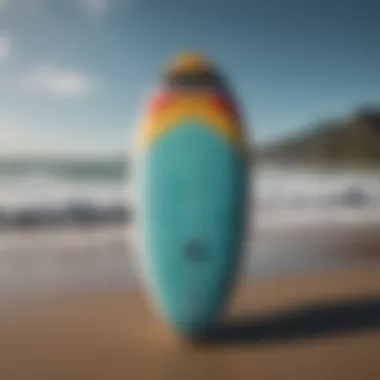Exploring Surfing: Techniques, Destinations, and Trends


Intro
Surfing stands as one of the most thrilling water sports. Not only does it require skill and balance, but it also provides a unique connection to the ocean. This sport has its roots in ancient traditions, yet it continues to evolve, captivating new enthusiasts every year.
This guide is structured to help both beginners and seasoned surfers navigate their way through the various components of the sport. As we examine surfing techniques, necessary equipment, popular locations, and essential safety measures, our goal is to provide clarity and depth to enrich your surfing experience.
Water Activity Overview
Whether you are drawn to heart-pounding waves or serene waters, understanding different water activities enhances your overall experience. Here, we will explore various water activities that complement surfing and provide insight into their unique aspects.
Surfing
Surfing involves riding waves using a surfboard. This might seem simple, but mastering the techniques requires practice and understanding of ocean dynamics. From recognizing swell patterns to reading tides, surf enthusiasts must develop a keen sense of awareness about the environment.
Sailing
Sailing offers its own thrill, though it is a different experience from surfing. It involves navigating a sailboat across bodies of water. The elements of the wind play a crucial part in your movement. Unlike surfing, it doesn't require several specific techniques like paddling and popping up. However, understanding wind patterns is essential.
Snorkeling
For those who prefer to stay below the water's surface, snorkeling offers an opportunity to explore marine life closely. This activity is much more relaxed compared to surfing. With the right gear—such as a mask, snorkel, and fins—you can immerse yourself in vibrant underwater landscapes.
Paddleboarding
Stand-up paddleboarding is another engaging activity, combining elements from surfing and kayaking. Users stand on a large board while using a paddle to navigate across various water surfaces. Its rising popularity provides an excellent platform for socializing or even indulging in workouts on the water.
Tips and Techniques
Acquiring surfing skills is not immediate. Let's outline useful tips to foster improvement both for beginners and for those more experienced.
Tips for beginners
- Start Small: Choose small, gentle waves to practice your balancing and paddling techniques.
- Positioning: Ensure your board is positioned perpendicular to the wave for optimal entry.
- Practice Crawling: Develop a strong pop-up from a lying position; this is crucial when catching waves.
Advanced techniques for experienced enthusiasts
- Foot Placement: Perfect foot placement enhances control and stability.
- Carving: Learn to carve turns by manipulating the edge of your board for a flowy ride.
- Vertical Knowledge: Familiarize yourself with vertical surfing to master negotiating steeper portions of waves.
Safety guidelines
- Know Your Limits: Always be conscious of your skill level and the difficulty of the waves.
- Observe the Ocean: Take time to understand waves, currents, and potential hazards.
- Leash Security: Always wear a leg leash to ensure that your board stays with you. This can prevent collisions with other surfers.
Proper training and situational awareness play significant roles in preventing accidents.
Gear Reviews
Investing in high-quality gear is vital for a fulfilling experience in surfing. Here are some essential items to consider.
Surfboards
Different board types suit various styles. For instance, soft-top boards are good for beginners, while performance shortboards cater to advanced surfers.
Wetsuits
Choosing the right wetsuit is crucial for comfort and thermal insulation, especially in colder waters. Look for appropriate thickness based on the conditions you will face.
Other types of swimming gear
- Snorkeling equipment: Ensure that your mask fits well to prevent water from leaking.
- Paddleboards: The material and size of your paddleboard can influence your paddling effectiveness.
Destination Guides
Finding the best surfing spots and water sports locations can enrich your experience significantly. Here is a look at popular and lesser-known destinations:
Popular water sports locations
Notable spots include:
- Hawaii: Renowned for big wave surfing.
- Gold Coast, Australia: Offers many surfing circuits and contests.
- California: The Pacific coastline gives surfers multiple breaks for every level.
Hidden gems for water enthusiasts
- Morocco: Known for consistent swells.
- Sri Lanka: Ideal for its warm water and beautiful beaches.
Travel tips for water sports trips
- Research: Always look up local rules or regulations regarding water activities.
- Equipment Rentals: Check options for high-quality rentals should you travel without your gear.
- Weather Check: Stay informed about the weather conditions in your destination before going.
Understanding and sailing through the diverse world of surfing and associated activities can take time and effort. However, with dedication and insight, water sports enthusiasts can enrich their milestones and ensure safer and good enjoyable experiences.
Prelims to Surfing
Surfing is not merely a water sport; it represents a unique blend of skill, physicality, and engagement with nature. Getting familiar with surfing allows one to appreciate and understand the intricate relationship between the surfer and ocean. This section discusses the fundamental components that constitute the foundation of surfing. By grasping these key ideas, enthusiasts can enhance their skills and determine the best ways to engage with such a dynamic and thrilling sport.
Understanding the Sport
And engaging introduction to surfing entails recognizing its diverse elements. At its core, surfing involves riding waves using a surfboard. Each element, from paddling out through the waves to executing turns, plays a crucial role in every successful ride. Moreover, the ocean provides varying conditions that can challenge a surfer’s adaptability and finesse. Advanced surfers often enjoy experimenting with various moving techniques while beginners may focus on mastering the basics.
The mental aspect should not be overlooked. Understanding sea arrangements, depths, and wave characteristics is essential. The ocean is unpredictable, especially during storms or high tides. Studying these aspects leads to greater respect and understanding of nature. Such comprehension correlates directly to improved performance on the water.
Another aspect is the community surrounding surfing, emphasizing camaraderie and respect. Word of mouth and shared experiences influence this sport heavily; knowing how to navigate within that community is also important.
The Appeal of Surfing
Surfing attracts enthusiasts for several reasons. Firstly, the continuous challenge of mastering new surf techniques keeps participants engaged. Each wave presents the possibility to learn something new, whether navigating faster currents or performing better turns.
Secondly, its connection to nature is mesmerizing. Surfers are often found at pristine beaches and breathtaking coastlines. This natural beauty captivates those spending hours on the water.
Moreover, the cultural richness that accompanies surfing contributes to its substantial allure. From documentaries to literature, the ethos of surfing runs deep, creating a unique identity. Surfers often partake in intense experiences, building deeper relationships with both the water and fellow surfers.
By embracing and understanding the core principles, surfers of all levels can embark on a rewarding journey within the compelling world of waves.


Surfing Techniques
In surfing, mastering techniques is essential for anyone looking to elevate their skills. This section explores fundamental skills and advanced techniques pivotal for enjoying the sport to its fullest while ensuring safety and performance. Both beginner and experienced surfers benefit from refining these abilities. Engaging in proper techniques fosters better control on the board and enhances the thrill of riding the waves.
Fundamental Skills
Paddling
Paddling is a core component of surfing, vital for getting out past the breaking waves. The ability to paddle efficiently determines how quickly a surfer can reach the lineup. It is characterized by a consistent and powerful stroke that generates speed.
The importance of paddling cannot be overstated. Gaining immediate momentum can make all the difference when catching a wave. As surfers learn to use their core and arms effectively, they become more competent in navigating different water conditions. Additionally, understanding the timing and rhythm of paddling contributes to overall performance.
Unique Feature: Paddling engages primarily the upper body, which may lead to fatigue if not managed well.
Advantages:
- Increases wave-catching potential
- Enhances physical fitness
Disadvantages:
- Requires stamina and strength development for many surfers.
Balancing
Balancing is crucial once a surfer is on the wave. Proper weight distribution creates stability, which is necessary for maneuvering and execution of tricks. Surfers must learn to shift their body weight depending on the size and shape of the wave.
This skill sets a strong foundation for progressing in the sport. Good balance allows surfers to perform turns and tricks with confidence. Developing this aspect fundamentally boosts overall surfing enjoyment.
Unique Feature: Balance can be improved away from the water through various exercises, increasing surfers' control in the water.
Advantages:
- Encourages fluid movements on the board
- Reduces fall risk during use of the board
Disadvantages:
- May be challenging for beginners initially without proper guidance.
Turning
Turning is essential for surfers looking to navigate the wave and perform maneuvers. It involves dynamic movement and coordination. Surfers need to learn how to shift their body weight, utilize the tail of the board and steer effectively.
Mastering turning opens the door to numerous possibilities on the waves. It is a skill central to advanced maneuvers that enhance a surfer's repertoire, translating into greater surfing accolades.
Unique Feature: Commands great understanding of the wave dynamics.
Advantages:
- Enables better wave positioning
- Plays a key role in tricks and displays personalized style
Disadvantages:
- Can be frustrating to master for some surfers.
Advanced Techniques
Cutbacks
Cutbacks allow surfers to reposition themselves on the wave, returning to the primary power source. This maneuver is a hallmark of skilled surfers, showcasing agility and board control. It's a vital technique because it aids surfers in sustaining their ride on powerful waves.
Key Characteristic: It demands timing, precision, and agility.
Advantages:
- Refreshes wave opportunities by regaining momentum
- Enhances style when performed smoothly
Disadvantages:
- It takes time to develop, possible risk of inconsistency.
Ollies
Ollies are advanced maneuvers boosting a surfer's ability to leap off the wave's crest or execute tricks. This jumps skill enable applications of creativity on the board, often leading to visually stunning expressions of skill.
Key Characteristic: Requires timing and confidence while on the board.
Advantages:
- Expands a surfer's performance repertoire
- Promises excitement in trick displays
Disadvantages:
- Higher risk of falls if premeditated poorly.
Tube Riding
Tube riding is arguably one of the most exhilarating aspects of surfing. When surfers successfully navigate down into the barrel of the wave, it creates a unique experience. Learning to tube ride takes time but is an element that many aspire to achieve.
Key Characteristic: It demonstrates deep understanding and technique commitment.
Advantages:
- Results in one of surfing’s most prized moments
- Allies with thrill-seeking adventures
Disadvantages:
- Risky; only achievable in larger, more powerful waves.
Mastering surfing techniques not only amplifies experiences but heightens the connection between the surfer and the ocean. Excelling in fundamental and advanced skills creates pathways for a greater understanding of the sport.
Essential Surfing Equipment
Essential surfing equipment plays a crucial role in ensuring a safe and enjoyable experience on the waves. With the right gear, surfers can streamline their progression and optimize performance. The right equipment also enhances safety, catering to varying weather conditions and surf styles. Understanding the types of surfboards, wetsuits, and accessories helps enthusiasts make informed decisions, which is essential for success.


Types of Surfboards
Shortboards
Shortboards are known for their agility and speed, making them a favorite among many surfers, especially for high-performance surfing. They typically range from 5 to 7 feet in length. Their key characteristic is the pointed nose, allowing sharp turns and quick response on the wave. A major benefit of shortboards is their ability to perform in a variety of wave conditions, which is favored by experienced surfers aiming for tricks and maneuvers. However, beginners may find them less stable compared to longer boards. This makes it important to assess personal skill level before committing to a shortboard.
Longboards
Longboards sweep the water with a classic and smooth style. Generally, these boards are over 8 feet long and are known for their balanced nature. The wide nose and tail create a feeling of stability, allowing new surfers to focus on foundational techniques. Longboards are ideal for smaller wave days and slower-paced surfing, which can be advantageous for learners. On the downside, their length may make performing quick turns more challenging than with shortboards.
Fish Boards
Fish boards make surfing a unique and innovative experience. Compact with a wider outline and often shorter than 6 feet, fish boards are excellent for catching small to medium waves. Their design includes a swallow tail, allowing quick response and maneuverability. These characteristics lead to increased speed and provide a fun experience, especially in smaller waves. Nevertheless, some surfers may feel limited in their performance on larger, steeper waves.
Wetsuits: Choosing the Right Gear
Selecting the appropriate wetsuit is vital for any surfer committed to comfort and protection days in the water. Wetsuits insulate body heat, allowing individuals to surf in colder waters. When sometimes the temperature drops, not having the right thickness can deter surfers from enjoying their time. Checkbox characteristics like thickness, fit, and flexibility can affect a surfer's overall experience, provides insulation, and ensures ease of movement.
Accessories for Optimal Performance
Waxes
Waxes are considered an essential component for improving grip on a surfboard. The rajctoryidean characteristic of wax is its ability to create friction between the foot and board surface. This promotes increased balance and control while riding waves. Choosing the correct type of wax for specific water temperatures can directly influence surfer performance. For example, tropical wax is softer and tackier but may not hold on colder waters.
Leashes
A leash connects the surfer to the surfboard, making its primary function to prevent losing the board after wiping out. An individual can use lengths according to board size, providing required safety and efficiency. The unique benefit of surfboard leashes includes maintaining control, making it safer both for the surfer and nearby surfers. It has exceptions, such as when submerged in crowded waters, where lengths can interfere.
Fins
Fins are integrated into surfboards, allowing a more dynamic manifestation. They manage stability, therefore directly influence ease of turns and overall speed when working into waves. Fins come in various shapes and sizes, elaborating different ways to interact with waves. Surfers must adapt and choose suitable fins, as they fend distinct reactions and personal contemplations, such as solid measurements in big swells, giving versatility.
Essential surfing equipment, when paired with proper skills and awareness, shapes the experiences enjoyed on the waves. Proper preparation leads to enhanced performance and longevity in this rewarding sport.
Surfing Safety
Surfing safety is paramount for anyone who engages in this sport. Understanding and acknowledging the potential dangers associated with surfing is vital for enjoyment and skill advancement. The ocean is dynamic, requiring surfers to become aware of various factors that contribute to both the beauty and peril of the waves.
Understanding Ocean Conditions
Knowledge of ocean conditions can greatly influence a surfer's experience. Factors like tide, swell, wind, and weather can change the surf environment rapidly. Awareness of these elements helps surfers make informed decisions, ensuring they choose the right time and spot for their activity.
- Tides can vary, presenting different situations throughout the day; surfers should understand which tides suit their skill level and preferred conditions.
- Swell gives surfers opportunities; but large swells may create powerful waves unsuitable for beginners.
- Wind positively or negatively impacts wave shape and surf quality. It's generally advisable to check the wind direction to select optimal conditions.
Surfers must monitor forecasts and respect nature. Awareness decreases accident likelihood, thus elevating the surfing experience.
Common Hazards and Precautions
Knowledge of common hazards plays a significant role in enhancingsurfing safety. These hazards highlight ) various risks surfers encounter daily while enjoying the waves. Key risks include rip currents, marine life, and collisions.
Rip Currents
Rip currents are powerful channels of water escaping from the shore. They can sweep surfers away from safety and pose a significant risk. A major characteristic of rip currents is their unpredictable nature. Surfers can suddenly find themselves pulled into deeper waters. Recognizing rip currents can greatly increase safety.
- How to Identify: Factors like choppiness, color change, or foam movement can indicate a rip current.
- Precautions: If caught in one, remaining calm and swimming parallel to the shore usually enables surfers to escape
Understanding rip currents is vital not only figor internal safety, but collectively contributes to making safer conditions for everyone on the water.
Marine Life
Marine life presents both wonder and danger for surfers. While enjoying the ocean, surfers may encounter various species, some of which can be dangerous. A critical characteristic of marine life is biodiversity. Each area may host unique creatures, leading to safety required considerations.
- Precautions Against Fish: While most marine life poses little threat, awareness reduces incidents. Researching local sea inhabitants before surfing can help.
- Potential Threats: It is customary to remain cautious around larger fish and shark-infested waters.
Acknowledging marine life in the water emphasizes respect and encourages safer practices while allowing surfers to have a deeper connection with their environment.
Collisions
Collisions are common yet serious incidents that surfers should guard themselves against. Surfing involves interacting not only with the waves but also with other surfers. A key aspect of collisions is their potential to cause injury. Most accidents arise from a lack of awareness.
- Avoiding Collisions: Focus on maintaining awareness of your surroundings to avoid collisions with other surfers. Staying on designated paths helps prevent dangerous encounters.
- Injuries from Equipment: Boards and fins can cause injuries if riders clash. Carrying surfboards responsibly reduces unexpected injuries.
Understanding the dynamics of possible collisions helps ensure safer conditions out in the ocean rienforcing a well-rounded perspective of surfing safety.
Surfing comes with joy and its share of risks. Keeping safety measures an priority transforms both the individual experience and others around you in pursuit of perfect waves.
Best Surfing Destinations
Choosing appropriate surfing destinattions is a vital consideration for any water sports enthusiasts. The quality of surf breaks, local culture, and environmental conditions can greatly influence a surfer's experience. This section provides insights into some of the most renowned surfing locations globally. Not only does it highlight the unique characteristics of these destinations, but it also informs surfers about what they can expect from each.
Global Hotspots
Hawaii
Hawaii is often regarded as the birthplace of surfing. Its powerful waves and stunning landscapes make it a premier surfing destination. The North Shore of Oahu is particularly famous for its big waves, attracting surfers from around the world. Waimea Bay, for instance, challenges even seasoned surfers with its large swells.
Moreover, the rich surfing culture in Hawaii enhances the overall experience, allowing surfers to connect with the sport’s history. One significant disadvantage, though, is the crowds. Popular surf spots can become congested during peak seasons. It's essential for beginners to be cautious in these busy environments. The natural beauty of the islands adds to Hawaii’s appeal, making it an unforgettable choice for surfers.
California
California boasts a diverse range of surf breaks that cater to all skill levels. From Malibu to Santa Cruz, the state's shoreline is dotted with iconic surf beaches. Places like Henry Miller's Swami's Beach have become renowned for their consistent waves. Many surfers believe that practicing here improves their skills.
A significant advantage is the surfing community culture, generally welcoming and inclusive, providing opportunities for networking and learning. As with Hawaii, crowded beaches can be a drawback, especially during summer months among tourists. Ultimately, California offers a blend of challenge and support, making it a wonderful choice for surfers.
Australia
Australia is known for its vast coastline and world-class waves. Locations like Gold Coast and Bondi Beach are crowd favorites, attracting surfers with their reliable swells and scenic environments. The variety of breaks available allows surfers the chance to test their skills against different types of waves.
One encouraging aspect of surfing in Australia is the awareness and support for beginners, with many schools and experienced instructors around. However, extreme weather and strong currents should be factored in, as they pose hazards to those unfamiliar with the waters. Australia's overall surfing culture notably fosters both adventure and growth.
Emerging Locations
Portugal


Portugal is rapidly gaining reputation as a surfing paradise primarily due to its excellent surf season, stretching from autumn to spring. Surf breaks like those found in Ericeira and Nazaré are remarkable destinations for both locals and tourists. Known for massive waves, Nazaré has become increasingly popular among pro surfers.
The affordability of Portugal compared to other top destinations can be received as a strong drawfactor for many. That said, language barriers can present some navigational challenges for foreign surfers needing assistnace. Still, Portugal's future in the surfing world appears bright, combining natural beauty with inviting culture.
Indonesia
Indonesia, particularly Bali, is an absolute favorite among surfers. The combination of warm waters and quality waves throughout the year is undeniably attractive. Surfing hotspots like Padang Padang present opportunities for experiencing world-class barrels.
On the flip side, with excess tourists comes less pristine nature. Navigating local customs can also be a challenge for international visitors at times. Regardless, Indonesia remains a robust and enticing option for any eager surfer.
Mexico
Mexico caters to all types of surfers, with variations in surf scripts available along its coastlines. Places like Puerto Escondido are known for their challenging conditions. The local atmosphere is typically laid-back, providing a pleasant atmosphere for both surfing and relaxation.
Affordability is another advantage, allowing surfers to travel without excessive financial strains. Language can interffere with interactions but is usually not a major barrier. Overall, Mexico present a delightful atmosphere for water sports enthusiasts.
The collection of some of the best surfing destinations worldwide bridges not only skillsets but invaluable cultural enrichments for the water sports community.
Community and Culture of Surfing
Surfing is more than just a sport; it embodies a lifestyle deeply intertwined with communities worldwide. The community surrounding surfing has a profound influence on enthusiasts, shaping their experiences and perceptions of the water sport. This culture promotes values such as respect for the ocean, collective learning, and fostering relationships amongst surfers.
Traditional surfing cultures hold a legacy that extends beyond the sport itself. Many surfers embrace a connection to the ocean, and this extends to how they interact with local ecosystems and environments. Advocating for sustainable practices frequently emerges in local surf communities, particularly with rising tides on conservation awareness. Thus, understanding surfing as a cultural phenomenon is fundamental to grasping the nuances present in the various localities around the world.
Surfing and Its Global Impact
The proliferation of surfing has been notable across numerous global locations. Over the years, it has thrown spotlight on different coastal communities. This popularity aids in preserving local environments, stimulation of economies, and cultural exchange.
Advocacy often springs from surf communities, aiming to protect coastlines. Surfing schools and programs frequently educate new generations on ocean conservation specifics. Importantly, surf tourism bolsters local economies, providing much-needed financial support to regions traditionally dependent on fisheries or agriculture.
"Joining a surf community opens doors to a rich network of experiences and growth both personally and ecologically.”
The Role of Surf Competitions
Surfing competitions serve as more than mere sporting events; they are a synthesis of talents, culture, and industry that contribute significantly to the sport's evolution. Competitions draw attention from media, attracting both participants and spectators. This cycle fuels growth in the sport while heightening the visibility of surfing globally.
Major Events
Key surfing competitions, such as the World Surf League, captivate participants and viewers alike. Major events bring a large congregation of talent in one location, generating anticipation and community linkage. These events also function as a stage for surfers striving toward elite status. Highlights include not just athletic prowess, but also showcases dedication and resilience displayed among competitors.
However, the pressure and scrutiny often associated with such events can create challenges for individual surfers. The performance-inducing atmosphere can lead to stress, sometimes affecting personal enjoyment of the sport.
Professional Surfing Organizations
Professional surfing organizations play a critical role in structuring the competitive landscape and establishing fair guidelines. Bodies like the International Surfing Association drive standardization, ensuring quality among competitions.
These organizations also promote surfing as an inclusive sport. Through scholarships and talent development programs, they find and foster new talents who may not otherwise have access to professional avenues. Thus, their commitment uplift communities, breaking socio-economic barriers.
Yet, their dictates and processes may seem disconnected from local surf cultures kissiegen. This creates occasional tensions between grassroots surfers and organizational mandates when authenticity risks being overshadowed by administratvie control.
Future Trends in Surfing
The dynamic world of surfing is not standing still. As the sport evolves, so do the aspects that shape it. Future trends have significant relevance for enthusiasts and professionals alike. Understanding these trends allows surfers to adapt to evolving techniques, equipment, and environmental considerations.
In recent years, technology has entered the surf scene, impacting the performance and experience of surfers. It leads to prolonged engagement with the sport through enhanced training opportunities. Coupling this with environmental awareness ensures the growth of sustainable methods in surfing.
Innovations and awareness are crucial as they push the boundaries of what is possible and necessary in responsible water sports participation.
Technological Advancements
Technology is increasingly integrated into surfing, bringing numerous benefits. One notable innovation is the advent of smart surfboards. These boards come equipped with sensors that track various aspects of a surf session, including speed, wave height, and distance. Having access to this data allows surfers to refine their skills and strategies for navigating waves.
Tech is also advancing surfboards. Manufacturers are using lighter and more durable materials such as carbon fiber, enhancing performance. E-foam crafting is on the rise and helps in reducing weight significantly while also giving added buoyancy.
"As surf technology continues to progress, the sport becomes more accessible and enjoyable for surfers of all levels."
Surfing resorts and virtual reality systems also heighten the training experience for new surfers. Cutting-edge surf tramps and wave generators run simulations mimicking actual surf conditions, giving novice surfers the chance to practice before hitting the ocean.
Environmental Considerations
Awareness of our environment grows stronger, impacting surfing trends significantly. Free of plastic use and emphasizing wave preservation, surfers are considering the ecological footprint of their sport more than ever. Responsible surf culture develops with a mindset centered on sustainability.
Sustainable Practices
Sustainable practices in surfing are about minimizing environmental damage and maintaining beautiful surf spots for future generations. This trend includes using eco-friendly surfboards crafted from biodegradable materials. By opting for sustainable manufacturing options, surfers can partake in developing techniques that have less ecological burden.
Choosing sustainable equipment also enhances aesthetic appeal. Boards are now often more visually pleasing when made with natural resurces.
The awareness of natural conservation efforts that encourage surfers to limit waste and actively engage in clean-up projects at local beaches is increasing steadily. These help utilize existing resources better and foster community bonds.
Conservation Efforts
Conservation efforts emphasize preserving delicate marine ecosystems affected by surfing activities. Lead by notable organizations, various initiatives focus on rehabilitating coastlines and marine habitats. By supporting projects designed to replace damaged areas and conserve wildlife, surfers play a crucial part in nurturing surfing-friendly environments.
Key characteristics of conservation efforts ensure long-lasting functions for surf spots and their surrounding locale. Selecting surfing destinations aligned with ecologically aware policies establishes a stronger commitment to the preservation of our oceans.
Moreover, many surf competitions are establishing greening policies promoting experiential responsible practices to prioritize marine environment preservation.
In essence, as surfing moves toward modernity, responsibility aligns closely with its future. Embracing advancements and sustainability ensures not only the joy of surfing today but the very existence of surfing tomorrow.
Culmination
Reflecting on the Journey of Surfing
The exploration of surfing offers keen insight into the depths of this exhilarating water sport. The article has drawn attention to various crucial aspects such as techniques, equipment, and safety, all of which play roles in fostering an enriched surfing experience. Every paragraph elucidates how engaging with surfing involves a commitment to both learning and respecting the ocean.
Engagement within the surfing community is vital for both individual growth and broader cultural implications. Surfing is not just a pastime; it reflects a unique lifestyle and a connection to nature. When reflecting on this journey, it becomes clear that embracing surfing brings one closer to communal ties and environmental considerations. As surfers navigate the waves, they also quest through self-discovery and camaraderie with others pursuing similar thrills.
This article emphasizes educational takeaways. Here are several key points to consider as you finalize your journey through this multifaceted landscape of surfing:
- Embodied Experience: Mastery of techniques like paddling and balancing is essential; thorough practice deepens understanding.
- Connection to Environment: Each surfing location offers distinct conditions; appreciation elevates awareness about environmental sustainability.
- Ongoing Evolution: Keeping abreast with technological advancements provides insight into surfing's future while contributing positively, for both personal advancement and community engagement.
Finally, let the spirit of surfing and the influence it has on individual lives and global culture be acknowledged. Surfing is not merely an adventure; it is a lifetime journey filled with opportunities for introspection, interaction, and inspiration.
“Surfing is communication through waves and water. It connects individuals regardless of distance.”
For more thoughts about surfing culture, visit resources such as Wikipedia and Britannica. A read through forums like Reddit can also help enthusiasts keep updated with real experiences and insights.
In summary, a true surfer is one who recognizes the beauty within the ride itself and carries that essence beyond the waves.















